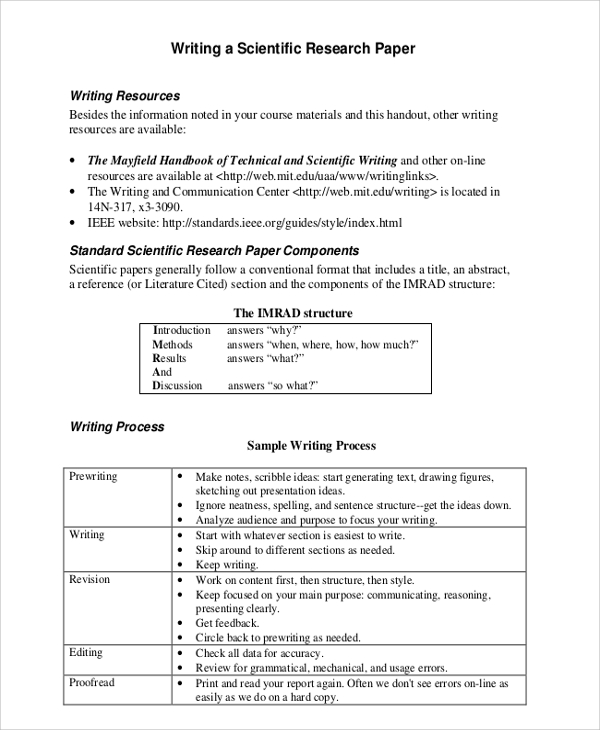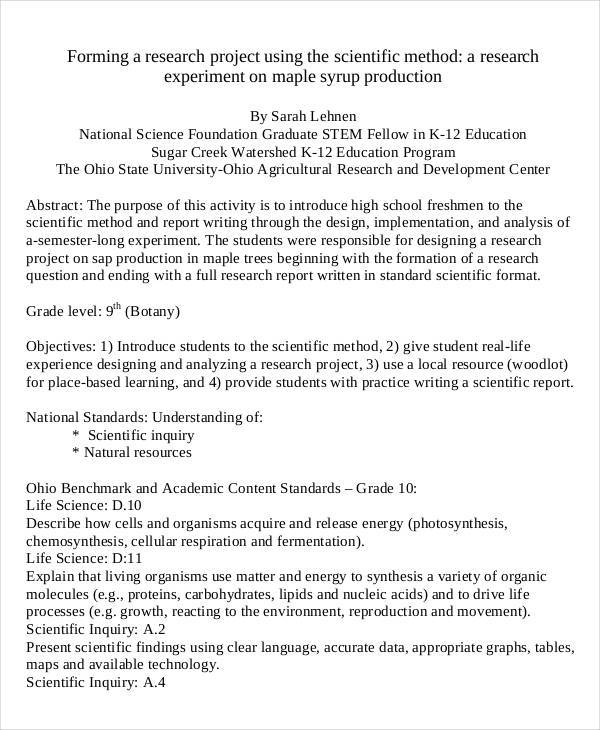
What follows is a hypothetical example of a research paper based on an experiment. The experiment: Say you have just conducted the Milgram Study. Now you want to write the research paper for it. (Milgram actually waited two years before writing about his study.) See our collection of science research paper examples. These example papers are to help you understanding how to write this type of written assignments. Science is a systematic enterprise that builds and organizes knowledge in the form of testable explanations and predictions about the universe. Contemporary science is typically subdivided into the natural sciences, which study the material universe; the social sciences, which study people and societies; and the formal sciences, It has been shown, for example, that parental plumage color has a strong effect on mate selection in male (but not female) zebra finches (Walter, ). All of the birds used in this study have been exposed to grass, green embroidery floss and white dog fur in nests
Sample Paper in Scientific Format – Writing Across the Curriculum – UW–Madison
View our latest COVID updates. Many of your Science units will require you to write a formal laboratory report. The purpose is to report on what scientific research report example did, what you learned from an experiment and why the findings matter.
Scientific research report example note that scientific research report example units require students to record notes and observations in logbooks in the laboratory. These have their own purpose and conventions and are different from lab reports. Lab reports can vary in length and format. These range from a form to fill in and submit before leaving the lab, to a formal written report. However, they all usually follow a similar basic structure. provides an overview of the report content, including findings and conclusions usually the last part of the document to be written may not be required in a short lab report.
presents results of the experiment graphically or by using tables. Figures often include error bars where applicable discusses how results were analysed, including error analysis, scientific research report example. lists the publication details of all scientific research report example cited in the text, scientific research report example, allowing readers to locate sources quickly and easily usually follows a specific referencing style.
Click on the links below to find out more about the different sections of scientific research report example lab report. Your title needs to reflect the purpose of the experiment.
Check with your demonstrator or lecturer for specific requirements. An abstract provides a brief overview of the experiment, including its findings and conclusions. In general the abstract should answer six questions:.
The most important thing to remember when writing the abstract is to be brief and state only what is relevant. No extraneous information should be included.
It also must be clear enough so someone who is unfamiliar with scientific research report example experiment could understand why you did what you did, and the conclusions you reached, without needing to read the rest of the report. An abstract should be written last even though it appears as the first section in your reportas it summarises information from all the other sections of the report.
The method section is where you describe what you actually did. It includes the procedure that was followed. This should be a report of what you actually did, not just what was planned. A typical procedure usually includes:. If any aspects of the experimental procedure were likely to contribute systematic error to the data and results, point this out in sufficient detail in this section.
Your description of the experimental set-up should be sufficient to allow someone else to replicate the experiment themselves. When you carry out an experiment, you usually follow a set of instructions such as these, which may include extra information to guide you through the steps. A burette was clamped to a retort stand and filled with standardised NaOH aq and the initial measurement was recorded.
The conical flask was placed below the burette, on top of a piece of white paper. Five drops of universal indicator solution were added to the flask When writing up the procedure, you must report what was actually done and what actually happened, and omit any extra information such as helpful hints included in the instructions.
Your goal for this section should be to include enough detail for someone else to replicate what you did and achieve a similar outcome. You should also scientific research report example any modifications to the original process introduced during the experiment. While most science units require that you report in the passive voicesome require the active voice.
In the example below, scientific research report example, the first person is used e, scientific research report example. This is accepted in some disciplines, but not others. Check your unit information or talk to your unit coordinator. Read samples of student reports below and identify which examples are written in passive voice, and which use active voice.
In this section, you present the main data collected during your experiment. Each key measurement needs to be reported appropriately. Data are often presented in graphs, scientific research report example, figures or tables. This section often also includes analysis of the raw data, such as calculations.
In some disciplines the analysis is presented under its own heading, in others it is included in the results section. An analysis of the errors or uncertainties in the experiment is also usually included in this section. Most numerical data are presented using tables or graphs. These need to be labelled appropriately to clearly indicate what is shown.
Note that in Fig. For most experiments an error analysis is important, and errors should be included in tables and on graphs. Also, it is always best to draw figures yourself if you can. If you do use figures from another source, indicate in the citation whether you have modified it in any way. When showing calculations, it is usual to show the general equation, and one worked example.
Where a calculation is repeated many times, the additional detail is usually included in an appendix, scientific research report example. Check the requirements given in your unit information or lab manual, or ask your tutor if you are unsure where to place calculations.
In some schools, like Biology, calculations that are too detailed to go into the main body of the report can be added in an appendix. The purpose of such appendices is to present the data gathered and demonstrate the level of accuracy obtained.
A chromatogram was produced for the unknown compound U, and each of the known compounds, scientific research report example, A-E. Rf values for each substance are listed in Table 1. As well as presenting the main findings of your experiment, it is important that you indicate how accurate your results are.
This is usually done through determining the level of uncertainty. The sources of error that you need to consider will vary between experiments, but you will usually need to factor in both random and systematic errors, scientific research report example.
Your error analysis should identify the main causes of uncertainty in your measurements, note any assumptions, and show how you have calculated any error bars.
Check with your demonstrator, tutor or lecturer if you are unsure about how to determine uncertainties or whether error bars are required for your experiment. Your discussion section should demonstrate how well you understand what happened in the experiment, scientific research report example.
You should:. The discussion example below is from a first-year Biology unit. The aim of this experiment was to identify decomposition rates of leaf breakdown to establish rates of energy transfer. It was expected that the leaves would show a far higher rate of decomposition in the shore zone, where there are more chances for sediments to rub against them. However the two zones show no significant difference in leaf breakdown, although these results are non-conclusive due to the limitations of this experiment.
The two zones of leaf decomposition were physically too close, and over the incubation period reeds were observed growing close to the limnetic zone. This may have negatively affected the accuracy of the results by reducing the differences in habitat at these sites, as seen in other experiments Jones et al. The results also had large standard deviations, possibly due to these physical constraints or human error in weighing leaves.
Further studies with more diverse zones and precise procedures should be undertaken in order to explore leaf decomposition and rates of energy transfer more effectively. Drag each description of each component of the Discussion section to its example. Notice the order in which the components make up a coherent Discussion section. The conclusion section should provide a take-home message summing up what has been learned from the experiment:.
In brief lab reports, the conclusion is presented at the end of the discussion, scientific research report example, and does not have its own heading.
Note that a conclusion should never introduce any new ideas or findings, only give a concise summary of those which have already been presented in the report. Click again to hide the comment. It is quite possible that you may have in-text citations in your lab reports. Typically these will be included in the introduction to establish evidence of background for current theories or topics. Your discussion section will often include in-text citations, to show how your findings relate to those in the published literature, or to provide evidence-based suggestions or explanations for what you observed.
When in-text citations are incorporated into your lab report, you must always have the full citations included in a separate reference list. The reference list is a separate section that comes after your conclusion and before any appendices. Check your lab manual or unit information to determine which referencing style is preferred. Carefully follow that referencing style for your in-text references and reference list. You can find examples and information about common referencing styles in the Citing and referencing Library guide, scientific research report example.
The following is an example of a reference list based on the in-text citations used in the Introduction and Conclusion sections in this tutorial.
It has been formatted in accordance with the CSIRO referencing style. Jones T, Smith K, Nguyen P, di Alberto P Effects of habitat overlap on population sampling. Environmental Ecology Journal 75 doi: Tian M, Castillo TL Solar heating uptake in Australia: rates, causes and effects. Energy Efficiency Reports. Report no. Many of your Science units will require you to write formal laboratory reports. Review the components of the Science laboratory report. Select the report section that relates to the statement.
Close Notification Close Notification Close Notification.
The Structure of Scientific Research Papers
, time: 10:19FREE 10+ Scientific Research Report Templates in PDF | MS Word | Free & Premium Templates

What follows is a hypothetical example of a research paper based on an experiment. The experiment: Say you have just conducted the Milgram Study. Now you want to write the research paper for it. (Milgram actually waited two years before writing about his study.) possible. Although taking the scientific paper as a model, the principles here apply equally to other, less formal project write-ups and reports. 2. The structure of a scientific report The normal scientific report has a standard structure (parts in parentheses are optional): 1. Title 2. Abstract / Summary 3. Introduction 4. Methods 5. Results Sample APA Research Paper Sample Title Page Running on Empty 1 Running on Empty: The Effects of Food Deprivation on Concentration and Perseverance Thomas Delancy and Adam Solberg Dordt College Place manuscript page headers one-half inch from the top. Put five spaces between the page header and the page number. Full title, authors, and school nameFile Size: KB

No comments:
Post a Comment